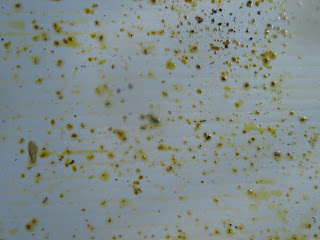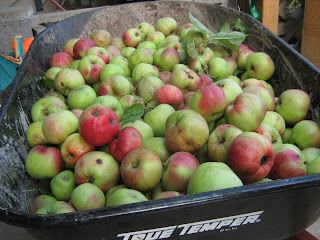Before I button-up the hives for the fall, I conducted varroa mite checks on my two hives. Varroa mites are parasites that attach themselves to honeybees and basically live off them until they die. If mite populations are high, they can quickly deplete a hive, especially in the winter. Conducting a mite check is very simple: spray a white corrugated sheet of plastic with oil and placed it under the hive for three days. Honeybees have very good hygiene and they groom the mites off of each other's bodies and the mites simply fall out of the hive and onto the white sheet of plastic.
The results:
Blue hive: 113 mites
White hive: 26 mites
These numbers are definitely not good in the fall of the year. 9 times out of 10, disease kills a hive before spring if the colony is not strong enough. Funny though----I performed a mite check on August 19th, only a month ago, and the mite numbers were 27 & 21. This is proof how fast these parasites multiply and how quickly they can decimate a hive.
(When I purchased this hive, it conveniently came with a slot that the mite board could slide into.)
(Pulling the mite board out...)
(This is what the mite board looks like after three days of being under the hive. On the board there are bee parts, dead spiders, pollen, dirt, earwigs, and mites.)
(In the very center of this picture is a varroa mite.)
(This picture shows what I see up close. How many mites can you see in this picture? I see 17!)
(This is what a varroa mite looks like under a microscope....gross...)

There are many ways to treat honeybees with varroa mites. One method is dusting the bees with powdered sugar to encourage grooming. I totally intended to do this but forgot the powdered sugar after opening the hive. I also made mite patties. These patties are basically 1 cup vegetable shortening mixed with 1/2 cup powdered sugar. Other beekeepers recommend using Honey-B-Healthy, so I added a capfull of that to the mixture as well. Mix everything together and place a patty onto waxed paper, face-up on top of the frames in the hive. The honeybees will want to remove this patty from the hive (and sometimes will eat it), and in the process get it on their bodies which will encourage grooming. The patty has oil in it which is also supposed to make it more difficult for the mites to cling to their bodies. Honey-B-Healthy is like "bee medicine" that contains lemongrass and other essential oils. Unfortunately it also contains sodium laurel sulfate which I didn't realize was in it until after I purchased it. That additive deserves a blog post all by itself, but it's on my list of "do not have in my house."


In addition to the mite patty I decided to feed the bees. Most beekeepers give their hives a big dose of sugar water in the fall to make sure the bees have enough food stores for the winter. My hives did produce some excess honey this year but not enough to extract (that's a messy job for only 5 frames of honey). I left this honey in the frames and will give it back to the bees in the spring instead of keeping it for myself. If I had extracted honey, then I would use the honey in the feeder in place of the sugar water that I mixed up. The picture above shows the feeder being filled with 2 cups sugar dissolved in 2 cups water with 1 tsp. Honey-B-Healthy mixed in. The bees crawl up through the hole in the center of the feeder and cling to the feeder walls and that plastic cup.
(The feeder lid is now on to keep bees from falling into the syrup. You may wonder why the inside of the hive cover is black. It's from the
scorching I did in the spring.
In a few days the feeder will be empty, and in a few weeks I will perform another mite check to see if what I did helped the bees in any way. Beekeeping for me is like walking a tightrope. I want to help my colonies survive, thrive, and produce a lot of excess honey, but I also don't want to feed them gallons of sugar water every spring and give them chemicals for disease treatments. I want to have strong honeybee genetics and produce bees with strong immune systems. By using chemicals, beekeepers are only producing stronger mites and other diseases. Am I making sense? Anyway, I'd be interested to hear other people's perspectives on this so leave your comments below!





































